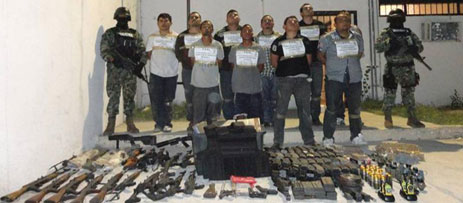By Sergio Chapa
KGBT
The American Consulate in Matamoros has issued a warning following a string of grenade attacks, including two of them against schools.
Residents have been using the #Matamoros hashtag of Twitter to report the attack over the past few days.
The Reforma News Agency reported that morning a high school and a college were both attacked on Monday morning.
No injuries were reported but residents said there were only property damages.
Nobody has claimed responsibility for the attacks but Tamaulipas remains a battleground state between former allies the Gulf Cartel and the Zetas.
Consulate officials issued a warning for American citizens south of the border on Monday afternoon.
According to the warning, there have been a series of attacks using explosive devices since Thursday.
The majority of the attacks have been in or near the Fraccionamiento Victoria on the city's southside but have not been limited to the area.
The consulate is asking its employees to exercise appropriate caution.
Security Message for U.S. Citizens: Explosive Device Attacks in Matamoros, Tamaulipas (June 4, 2012)
Since May 31, multiple explosive devices have been reported in Matamoros, several of which have detonated. The majority of these devices were located in Matamoros near Fraccionamiento Victoria Seccion Fiesta, but are not limited to that area. U.S. Consulate General employees are being advised to exercise appropriate caution in their movements.
For the latest security information, U.S. citizens traveling abroad should regularly monitor the Department's internet web site at http://travel.state.gov/ where the current Worldwide Caution, Travel Warnings, and Travel Alerts can be found. Up-to-date information on security can also be obtained by calling 1-888-407-4747 toll free in the United States and Canada, or, for callers from Mexico, a regular toll line at 001-202-501-4444. These numbers are available from 8:00 a.m. to 8:00 p.m. Eastern Time, Monday through Friday (except U.S. federal holidays).
Please review the Department of State’s Travel Warning concerning travel within Mexico and the state of Tamaulipas, available athttp://travel.state.gov/travel/cis_pa_tw/tw/tw_5665.html. The Department continues to advise U.S. citizens to defer non-essential travel to the state of Tamaulipas. We also encourage U.S. citizens living or traveling abroad to register with the nearest U.S. Embassy or Consulate through the State Department's travel registration web site at https://travelregistration.state.gov/ibrs/ui/ so that they can obtain updated information on travel and security. Americans without internet access may register in person or by phone with the nearest U.S. Embassy or Consulate. By registering, American citizens make it easier for the Embassy or Consulate to contact them in case of emergency.
For any emergencies involving American citizens in the Matamoros consular district, please call or visit the American Citizens Services (ACS) Unit at the U.S. Consulate General on Avenida Primera 2002, Col. Jardin, Matamoros, Tamaulipas; telephone (011)(52)(868) 812-4402;http://matamoros.usconsulate.gov/.
Sincerely,
American Citizen Services


























